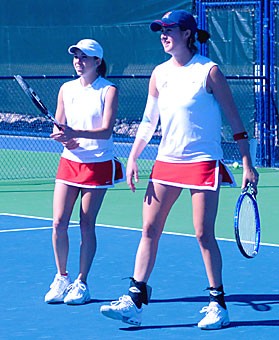There are not many collegiate sports in which the athletes have as much control over the match’s outcome as in tennis.
Players not only make their own line calls but also question their opponents’ calls, a power that also correlates to team tennis.
Another, more subtle way the outcome of a match is affected is the way teams set their singles and doubles lineups.
IThe official rule regarding lineup formation, according to the United States Tennis Association, the source of NCAA tennis regulations, states that “”players must play in order of ability.””
But while it would appear the best situation would be for teams to put their best players at the top positions, some have found that to win they must reject this assumption.
Currently, the UA women’s tennis team has its No. 1 and No. 2 singles players, No. 40 sophomore Danielle Steinberg and junior Juliette Mavroleon, at the No. 2 and No. 3 doubles positions, respectively.
This strategy has appeared to work, as the Wildcats have won the doubles point in their last five matches.
“”The team is more important than any individual ranking,”” said UA women’s head coach Vicky Maes. “”We have to do what’s right for the group and do everything we can to win. So as long as I feel that breaking up (Steinberg and Mavroleon) and doing well at all positions are what we need to do to win the doubles point, that is what we are going to do.””
Just because Arizona’s doubles lineup isn’t in the order of the athletes’ rankings, that doesn’t mean the team is stacking.
“”There is no correlation between singles and doubles,”” Pacific 10 Conference spokesman Mike Bruscas said. “”So if someone is a much better singles player, they can play No. 1 and they don’t even have to play doubles (if they’re not a good doubles player).””
Doubles lineups like Arizona’s are not uncommon. But when top-ranked players appear lower on a team’s singles lineup, it can sometimes raise suspicion.
One example is the Stanford women’s team, which has a No. 89 player, Theresa Logar, at the No. 1 singles spot, while No. 8 Jessica Nguyen competes at the No. 4 position.
The reason teams with such lineups are not subject to penalty is that technically, rankings don’t always match players’ ability.
National records are based off a formula and a point system that treasures players’ records, said Brian Ramirez, UA women’s assistant coach.
Consequently, younger players can be ranked at higher positions than a junior or senior simply because their winning percentages are better.
“”Essentially (the system) is computer rankings and they are fairly objective,”” Ramirez said. “”It all depends on who you play and who you beat throughout the year.””
Few teams try to get away with stacking a lineup – moving better players lower in the lineup to pick up more wins – because coaches usually know opposing teams , especially those in their conference. Thus, it is unlikely an illegal move would be missed.
“”In college tennis you see (stacking) every now and then,”” said UA men’s coach Tad Berkowitz said. “”But for the most part the coaches are going to have enough respect for each other that they will talk about it right then and there.””
In the instances when a team will not change its lineup, coaches can file a complaint to Pac-10 Commissioner Tom Hansen, who reviews the situation and assigns a proper penalty.
Berkowitz said he thinks stacking shows a lack of confidence in athletes.
“”That just means that (coaches are) afraid and don’t have faith in their team so they have to try different things,”” he said.









